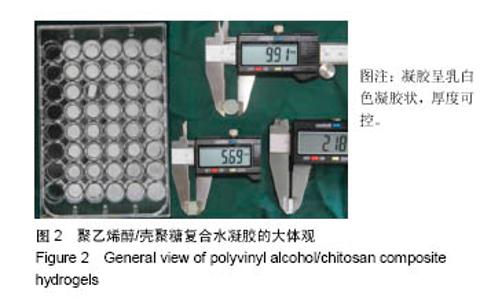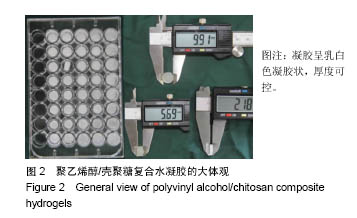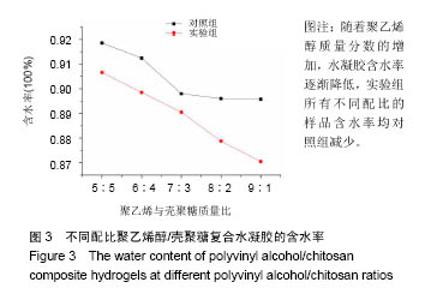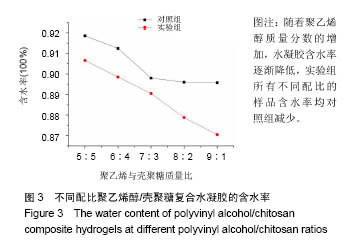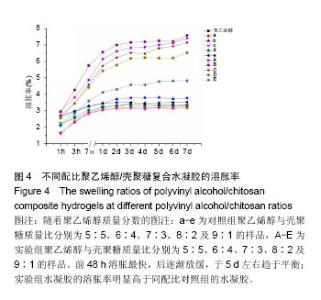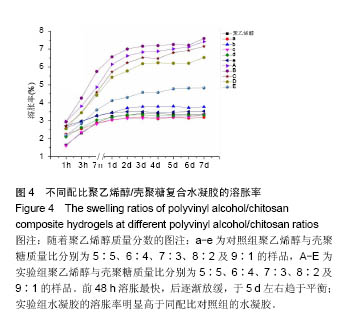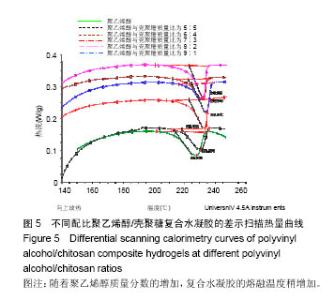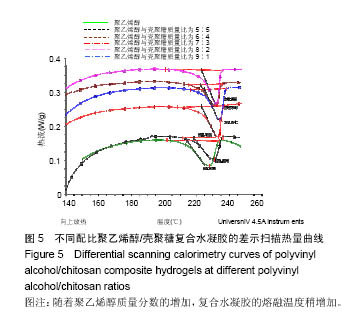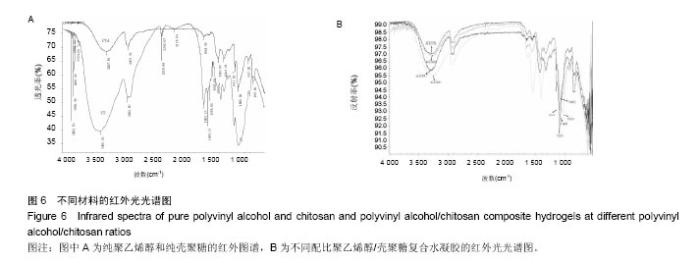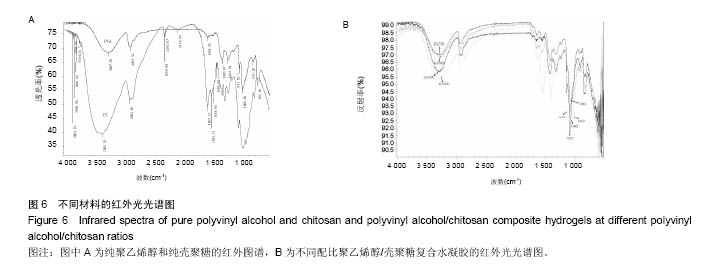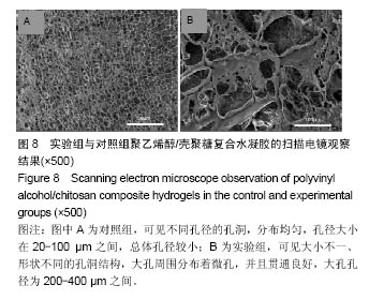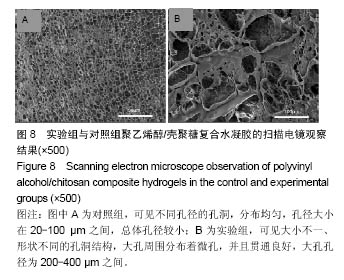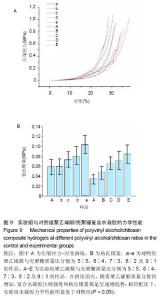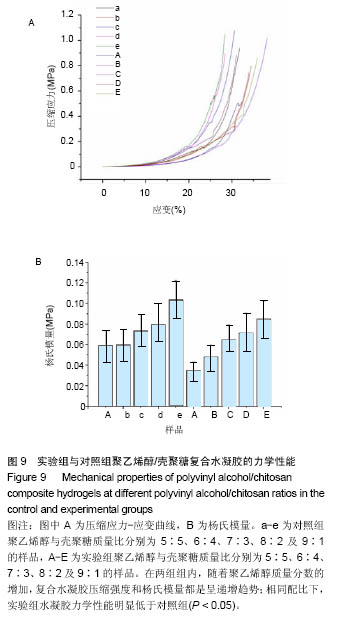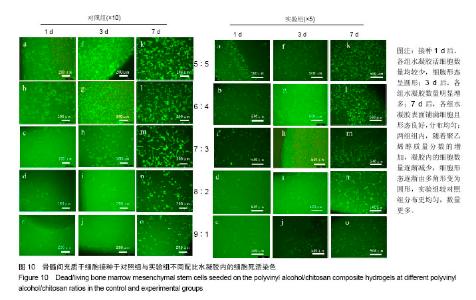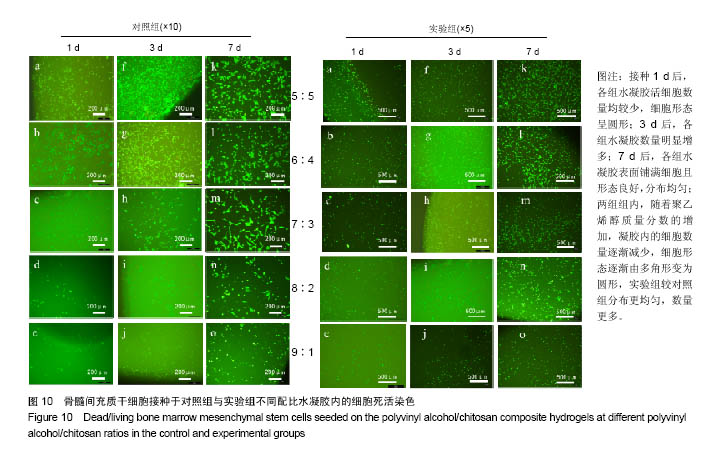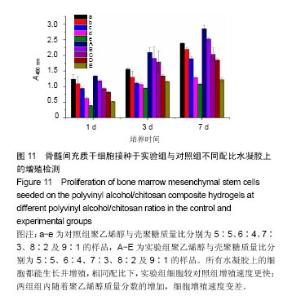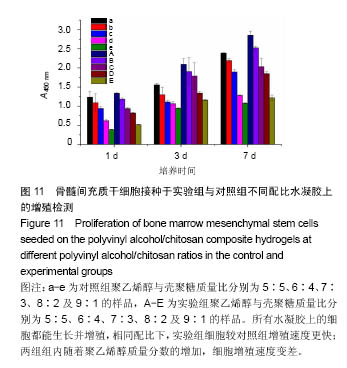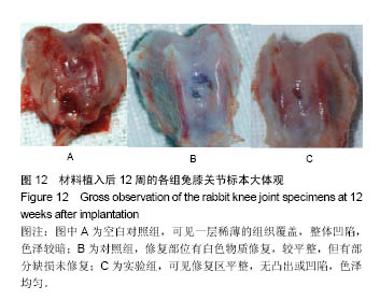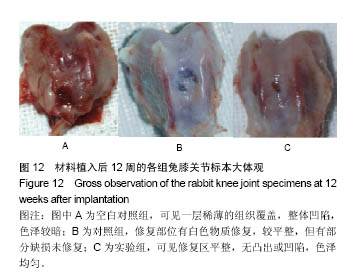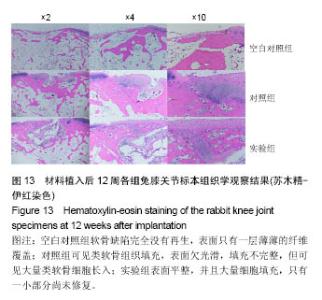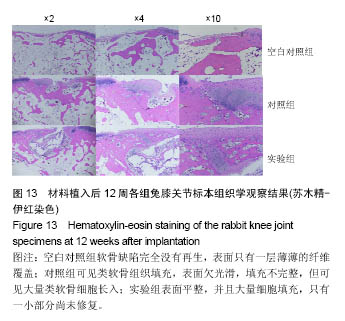Chinese Journal of Tissue Engineering Research ›› 2017, Vol. 21 ›› Issue (18): 2881-2889.doi: 10.3969/j.issn.2095-4344.2017.18.016
Previous Articles Next Articles
Repair of articular cartilage defects with polyvinyl alcohol/chitosan porous hydrogel combined with bone marrow mesenchymal stem cells
- 1Guangzhou Medical University, Guangzhou 510182, Guangdong Province, China; 2Shenzhen Key Laboratory of Tissue Engineering, Shenzhen 518035, Guangdong Province, China; 3Department of Sports Medicine, the Second People’s Hospital of Shenzhen, Shenzhen518035, Guangdong Province, China)
-
Received:2017-04-30Online:2017-06-28Published:2017-07-07 -
Contact:Wang Da-ping, Chief physician, Doctoral supervisor, Guangzhou Medical University, Guangzhou 510182, Guangdong Province, China; Shenzhen Key Laboratory of Tissue Engineering, Shenzhen 518035, Guangdong Province, China; Department of Sports Medicine, the Second People’s Hospital of Shenzhen, Shenzhen 518035, Guangdong Province, China -
About author:Zhou Yong, Studying for master’s degree, Guangzhou Medical University, Guangzhou 510182, Guangdong Province, China; Shenzhen Key Laboratory of Tissue Engineering, Shenzhen 518035, Guangdong Province, China -
Supported by:the Scientific Plan Project of Shenzhen City, No. JCYJ2015033010240109
CLC Number:
Cite this article
Zhou Yong, Jia Zhao-feng, Liu Wei, Zhu Wei-min, Cui Jia-ming, He Yong, Chen Jie-lin, Wang Da-ming, Peng Liang-quan, Wang Da-ping .
share this article
| [1]Duan L,Liang Y,Ma B,et al.Epigenetic regulation in chondrocyte phenotype maintenance for cell-based cartilage repair.Am J Transl Res.2015;7(11):2127-2140.[2]Wang D,Liu W,Feng Q,et al.Effect of inorganic/organic ratio and chemical coupling on the performance of porous silica/chitosan hybrid scaffolds.Mater Sci Eng C Mater Biol Appl. 2017;70(Pt 2):969-975. [3]Brix M,Kaipel M,Kellner R,et al.Successful osteoconduction but limited cartilage tissue quality following osteochondral repair by a cell-free multilayered nano-composite scaffold at the knee. Int Orthop.2016;40(3):1-8.[4]Sanchotello M,Forriol F,Gastaldi P,et al.Time evolution of in vivo articular cartilage repair induced by bone marrow stimulation and scaffold implantation in rabbits.Int J Artif Organs. 2015;38(4):210-223.[5]Xia WY,Wei L,Lei C,et al.The experimental study of tissue engineered autologous cartilage using chitosan-gelatin complex scaffolds.Zhonghua Yi Xue Za Zhi.2003;83(7): 577-579.[6]Jia S,Zhang T,Xiong Z,et al.In Vivo Evaluation of a Novel Oriented Scaffold-BMSC Construct for Enhancing Full-Thickness Articular Cartilage Repair in a Rabbit Model. PLoS One. 2015;10(12):e0145667. [7]Muhonen V,Salonius E,Haaparanta AM,et al.Articular cartilage repair with recombinant human type II collagen/polylactide scaffold in a preliminary porcine study.J Orthop Res.2016;34(5):745-753.[8]Reyes R,Delgado A,Solis R,et al.Cartilage repair by local delivery of transforming growth factor-β1 or bone morphogenetic protein-2 from a novel, segmented polyurethane/polylactic- co -glycolic bilayered scaffold.J Biomed Mater Res A.2014;102(4):1110-1120.[9]Park JH,Jung JW,Kang HW,et al.Indirect three-dimensional printing of synthetic polymer scaffold based on thermal molding process.Biofabrication.2014;6(2):025003.[10]Rahmanianschwarz A,Held M,Knoeller T,et al.In vivo biocompatibility and biodegradation of a novel thin and mechanically stable collagen scaffold.J Biomed Mater Res A.2014;102(4):1173-1179.[11]Wang X,Yan Y,Zhang R.Rapid prototyping as a tool for manufacturing bioartificial livers. Trends Biotechnol. 2007; 25(11):505-513.[12]Hoque ME,Chuan YL,Pashby I.Extrusion based rapid prototyping technique: An advanced platform for tissue engineering scaffold fabrication.Biopolymers.2012;97(2): 83-93.[13]Chen L,Zhu WM,Fei ZQ,et al.The study on biocompatibility of porous nHA/PLGA composite scaffolds for tissue engineering with rabbit chondrocytes in vitro.Biomed Res Int.2013;2013: 412745.[14]Islam A,Yasin T,Gull N,et al.Evaluation of selected properties of biocompatible chitosan/poly(vinyl alcohol) blends.Int J Biol Macromol.2016;82:551-556.[15]Jaipaew J,Wangkulangkul P,Meesane J,et al.Mimicked cartilage scaffolds of silk fibroin/hyaluronic acid with stem cells for osteoarthritis surgery: Morphological, mechanical, and physical clues.Mater Sci Eng C Mater Biol Appl.2016; 64:173-182.[16]Qi BW,Yu AX,Zhu SB,et al.Chitosan/poly(vinyl alcohol) hydrogel combined with Ad-hTGF-β1 transfected mesenchymal stem cells to repair rabbit articular cartilage defects.Exp Biol Med (Maywood).2013;238(1):23-30. [17]Morille M,Toupet K,Montero-Menei CN,et al. PLGA-based microcarriers induce mesenchymal stem cell chondrogenesis and stimulate cartilage repair in osteoarthritis.Biomaterials. 2016;88:60-69.[18]Kanimozhi K,Khaleel Basha S,Sugantha Kumari V. Processing and characterization of chitosan/PVA and methylcellulose porous scaffolds for tissue engineering.Mater Sci Eng C Mater Biol Appl. 2016;61:484-491.[19]Kanimozhi K,Khaleel BS,Sugantha KV.Processing and characterization of chitosan/PVA and methylcellulose porous scaffolds for tissue engineering.Mater Sci Eng C Mater Biol Appl. 2016;61:484-491.[20]Vikingsson L,Sancho-Tello M,Ruiz-Sauri A,et al.Implantation of a polycaprolactone scaffold with subchondral bone anchoring ameliorates nodules formation and other tissue alterations.Int J Artif Organs.2016;38(12):659-666.[21]Vicentini DS,Smania A,Laranjeira MCM.Chitosan/poly (vinyl alcohol) films containing ZnO nanoparticles and plasticizers. Mater Sci Eng C.2010;30(4):503-508.[22]Nava MM,Draghi L,Giordano C,et al.The effect of scaffold pore size in cartilage tissue engineering.J Appl Biomater Funct Mater.2016;14(3):e223-229.[23]Han F,Zhou F,Yang X,et al.A pilot study of conically graded chitosan-gelatin hydrogel/PLGA scaffold with dual-delivery of TGF-beta1 and BMP-2 for regeneration of cartilage-bone interface.J Biomed Mater Res B Appl Biomater. 2015;103(7): 1344-1353.[24]Chu J,Zeng S, Gao L,et al.Poly (L-lactic acid) porous scaffold-supported alginate hydrogel with improved mechanical properties and biocompatibility.Int J Artif Organs. 2016;39(8):435-443.[25]Olubamiji AD,Izadifar Z,Si JL,et al.Modulating mechanical behaviour of 3D-printed cartilage-mimetic PCL scaffolds: influence of molecular weight and pore geometry. Biofabrication. 2016;8(2):025020.[26]Dvir T,Tsur-Gang O,Cohen S.“Designer”scaffolds for tissue engineering and regeneration. Israel J Chem. 2005;45(4): 487-494.[27]Bian W,Lian Q,Li D,et al.Morphological characteristics of cartilage-bone transitional structures in the human knee joint and CAD design of an osteochondral scaffold. Biomed Eng Online. 2016;15(1):82. [28]Zhu W,Guo D,Peng L,et al.Repair of rabbit cartilage defect based on the fusion of rabbit bone marrow stromal cells and Nano-HA/PLLA composite material.Artif Cells Nanomed Biotechnol. 2017;45(1):115-119. [29]Li X,Ding J,Zhang ZZ,et al.Kartogenin-Incorporated Thermogel Supports Stem Cells for Significant Cartilage Regeneration.ACS Appl Mater Interfaces.2016;8(8): 5148-5159.[30]Yao Q,Nooeaid P,Detsch R,et al.Bioglass(R)/chitosan- polycaprolactone bilayered composite scaffolds intended for osteochondral tissue engineering.J Biomed Mater Res A. 2014;102(12):4510-4518.[31].Liao J,Shi K,Ding Q,et al.Recent developments in scaffold-guided cartilage tissue regeneration. J Biomed Nanotechnol.2014;10(10):3085-3104.[32]Gaaz T,Sulong A,Akhtar M,et al.Properties and Applications of Polyvinyl Alcohol,Halloysite Nanotubes and Their Nanocomposites.Molecules.2015;20(12):19884.[33]Rodriguez-Vazquez M,Vega-Ruiz B,Ramos-Zuniga R,et al. Chitosan and Its Potential Use as a Scaffold for Tissue Engineering in Regenerative Medicine.Biomed Res Int.2015; 2015:821279. |
| [1] | Yao Xiaoling, Peng Jiancheng, Xu Yuerong, Yang Zhidong, Zhang Shuncong. Variable-angle zero-notch anterior interbody fusion system in the treatment of cervical spondylotic myelopathy: 30-month follow-up [J]. Chinese Journal of Tissue Engineering Research, 2022, 26(9): 1377-1382. |
| [2] | Wang Jing, Xiong Shan, Cao Jin, Feng Linwei, Wang Xin. Role and mechanism of interleukin-3 in bone metabolism [J]. Chinese Journal of Tissue Engineering Research, 2022, 26(8): 1260-1265. |
| [3] | Xiao Hao, Liu Jing, Zhou Jun. Research progress of pulsed electromagnetic field in the treatment of postmenopausal osteoporosis [J]. Chinese Journal of Tissue Engineering Research, 2022, 26(8): 1266-1271. |
| [4] | An Weizheng, He Xiao, Ren Shuai, Liu Jianyu. Potential of muscle-derived stem cells in peripheral nerve regeneration [J]. Chinese Journal of Tissue Engineering Research, 2022, 26(7): 1130-1136. |
| [5] | Tian Chuan, Zhu Xiangqing, Yang Zailing, Yan Donghai, Li Ye, Wang Yanying, Yang Yukun, He Jie, Lü Guanke, Cai Xuemin, Shu Liping, He Zhixu, Pan Xinghua. Bone marrow mesenchymal stem cells regulate ovarian aging in macaques [J]. Chinese Journal of Tissue Engineering Research, 2022, 26(7): 985-991. |
| [6] | Hou Jingying, Guo Tianzhu, Yu Menglei, Long Huibao, Wu Hao. Hypoxia preconditioning targets and downregulates miR-195 and promotes bone marrow mesenchymal stem cell survival and pro-angiogenic potential by activating MALAT1 [J]. Chinese Journal of Tissue Engineering Research, 2022, 26(7): 1005-1011. |
| [7] | Liang Xuezhen, Yang Xi, Li Jiacheng, Luo Di, Xu Bo, Li Gang. Bushen Huoxue capsule regulates osteogenic and adipogenic differentiation of rat bone marrow mesenchymal stem cells via Hedgehog signaling pathway [J]. Chinese Journal of Tissue Engineering Research, 2022, 26(7): 1020-1026. |
| [8] | Wen Dandan, Li Qiang, Shen Caiqi, Ji Zhe, Jin Peisheng. Nocardia rubra cell wall skeleton for extemal use improves the viability of adipogenic mesenchymal stem cells and promotes diabetes wound repair [J]. Chinese Journal of Tissue Engineering Research, 2022, 26(7): 1038-1044. |
| [9] | Zhu Bingbing, Deng Jianghua, Chen Jingjing, Mu Xiaoling. Interleukin-8 receptor enhances the migration and adhesion of umbilical cord mesenchymal stem cells to injured endothelium [J]. Chinese Journal of Tissue Engineering Research, 2022, 26(7): 1045-1050. |
| [10] | Fang Xiaolei, Leng Jun, Zhang Chen, Liu Huimin, Guo Wen. Systematic evaluation of different therapeutic effects of mesenchymal stem cell transplantation in the treatment of ischemic stroke [J]. Chinese Journal of Tissue Engineering Research, 2022, 26(7): 1085-1092. |
| [11] | Guo Jia, Ding Qionghua, Liu Ze, Lü Siyi, Zhou Quancheng, Gao Yuhua, Bai Chunyu. Biological characteristics and immunoregulation of exosomes derived from mesenchymal stem cells [J]. Chinese Journal of Tissue Engineering Research, 2022, 26(7): 1093-1101. |
| [12] | Zhang Jinglin, Leng Min, Zhu Boheng, Wang Hong. Mechanism and application of stem cell-derived exosomes in promoting diabetic wound healing [J]. Chinese Journal of Tissue Engineering Research, 2022, 26(7): 1113-1118. |
| [13] | Huang Chuanjun, Zou Yu, Zhou Xiaoting, Zhu Yangqing, Qian Wei, Zhang Wei, Liu Xing. Transplantation of umbilical cord mesenchymal stem cells encapsulated in RADA16-BDNF hydrogel promotes neurological recovery in an intracerebral hemorrhage rat model [J]. Chinese Journal of Tissue Engineering Research, 2022, 26(4): 510-515. |
| [14] | Le Guoping, Zhang Ming, Xi Licheng, Luo Hanwen. Preparation and in vitro evaluation of vancomycin hydrochloride@polylactic acid-glycolic acid copolymer-chitosan-hyaluronic acid composite sustained-release microspheres [J]. Chinese Journal of Tissue Engineering Research, 2022, 26(4): 528-534. |
| [15] | He Yunying, Li Lingjie, Zhang Shuqi, Li Yuzhou, Yang Sheng, Ji Ping. Method of constructing cell spheroids based on agarose and polyacrylic molds [J]. Chinese Journal of Tissue Engineering Research, 2022, 26(4): 553-559. |
| Viewed | ||||||
|
Full text |
|
|||||
|
Abstract |
|
|||||
